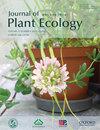Leaf litter decomposition characteristics and controlling factors across two contrasting forest types
IF 3.9
2区 环境科学与生态学
Q2 ECOLOGY
引用次数: 0
Abstract
Plant leaf litter decomposition provides a source of energy and nutrients in forest ecosystems. In addition to traditional environmental factors, the degradation process of litter is also affected by plant functional traits and litter quality. However, at the community level, it is still unclear whether the relative importance of plant traits and litter quality on the litter decomposition rate is consistent. A year-long mixed leaf litter decomposition experiment in a similar environment was implemented by using the litterbag method in seven typical forest types in Dongling Mountain, Beijing, North China, including six monodominant communities dominated by Juglans mandshurica, Populus cathayana, Betula dahurica, B. platyphylla, Pinus tabuliformis and Larix gmelinii var. principis-rupprechtii and one codominant community dominated by Fraxinus rhynchophylla, Quercus mongolica and Tilia mongolica. The results showed that there were considerable differences in the litter decomposition rate (k-rate) among the different forest types. The community weighted mean (CWM) traits of green leaves and litter quality explained 35.60% and 9.05% of the k-rate variations, respectively, and the interpretation rate of their interaction was 23.37%, indicating that the CWM traits and their interaction with litter quality were the main factors affecting the k-rate variations. In the RDA, leaf nitrogen content, leaf dry matter content, leaf tannin content and specific leaf area were the main factors affecting the k-rate variations. Therefore, we suggest that future studies should focus on the effects of the CWM traits of green leaves on litter decomposition at the community level.两种不同林型落叶分解特征及控制因素
植物凋落叶分解为森林生态系统提供了能量和养分的来源。除传统环境因素外,凋落物的降解过程还受植物功能性状和凋落物质量的影响。然而,在群落水平上,植物性状和凋落物质量对凋落物分解速率的相对重要性是否一致尚不清楚。采用凋落物袋法在相似环境下对北京东陵山7个典型林型进行了为期1年的混合凋落物分解试验,包括以山核桃、白杨、白桦、白桦、油松和华北落叶松为优势的6个单优势群落和以黑曲柳、蒙古栎和蒙古椴为优势的1个共优势群落。结果表明,不同林型凋落物分解速率(k-rate)存在较大差异。群落加权平均(CWM)性状和凋落物质量性状对k率变异的解释分别为35.60%和9.05%,二者交互作用的解释率为23.37%,表明CWM性状及其与凋落物质量的交互作用是影响k率变异的主要因素。在RDA中,叶片氮含量、叶片干物质含量、叶片单宁含量和比叶面积是影响钾速率变化的主要因素。因此,我们建议未来的研究应集中在群落水平上研究绿叶CWM性状对凋落物分解的影响。
本文章由计算机程序翻译,如有差异,请以英文原文为准。
求助全文
约1分钟内获得全文
求助全文
来源期刊

Journal of Plant Ecology
生物-植物科学
CiteScore
4.60
自引率
18.50%
发文量
134
审稿时长
3 months
期刊介绍:
Journal of Plant Ecology (JPE) serves as an important medium for ecologists to present research findings and discuss challenging issues in the broad field of plants and their interactions with biotic and abiotic environment. The JPE will cover all aspects of plant ecology, including plant ecophysiology, population ecology, community ecology, ecosystem ecology and landscape ecology as well as conservation ecology, evolutionary ecology, and theoretical ecology.
 求助内容:
求助内容: 应助结果提醒方式:
应助结果提醒方式:


